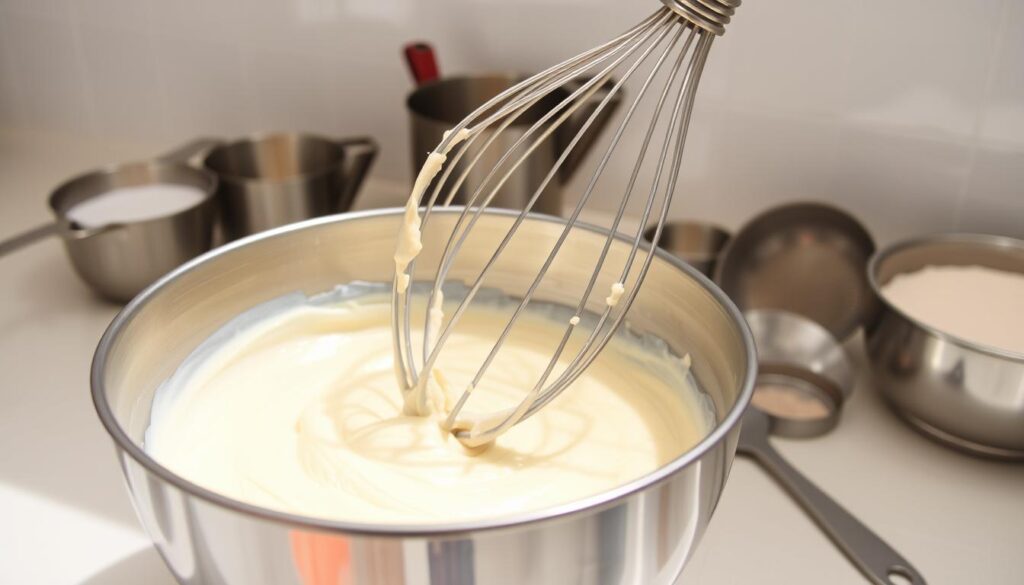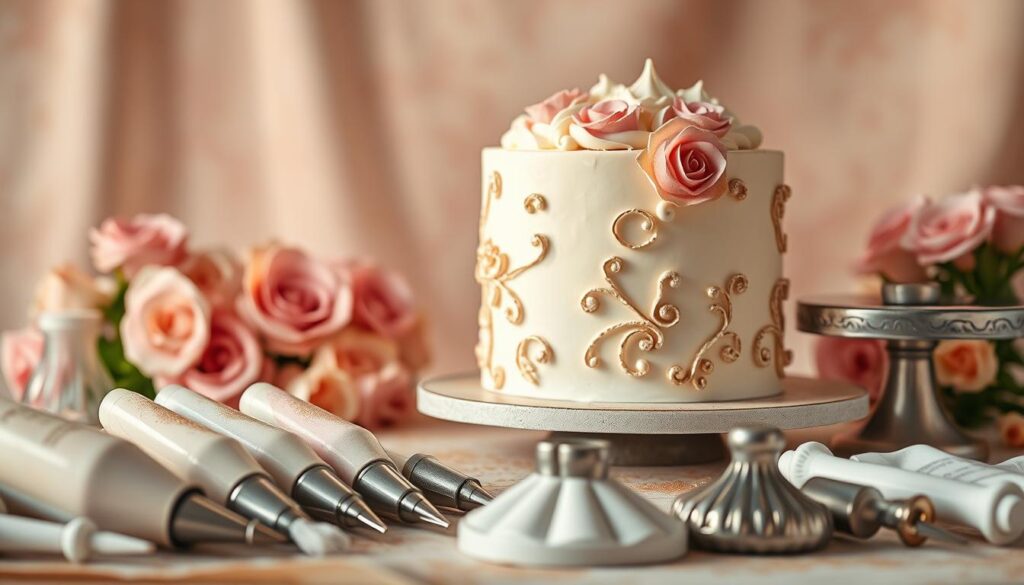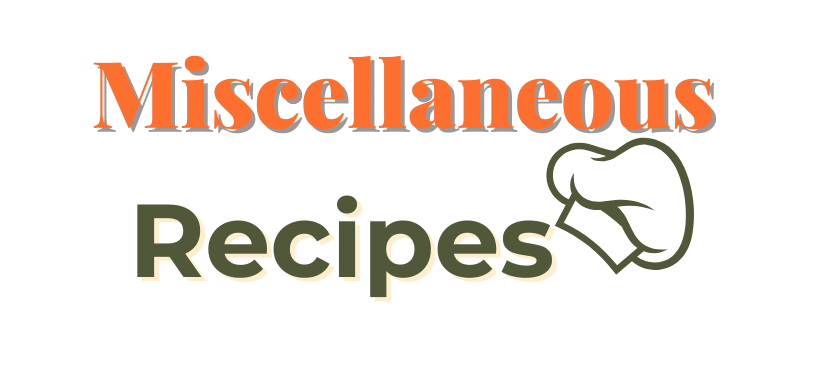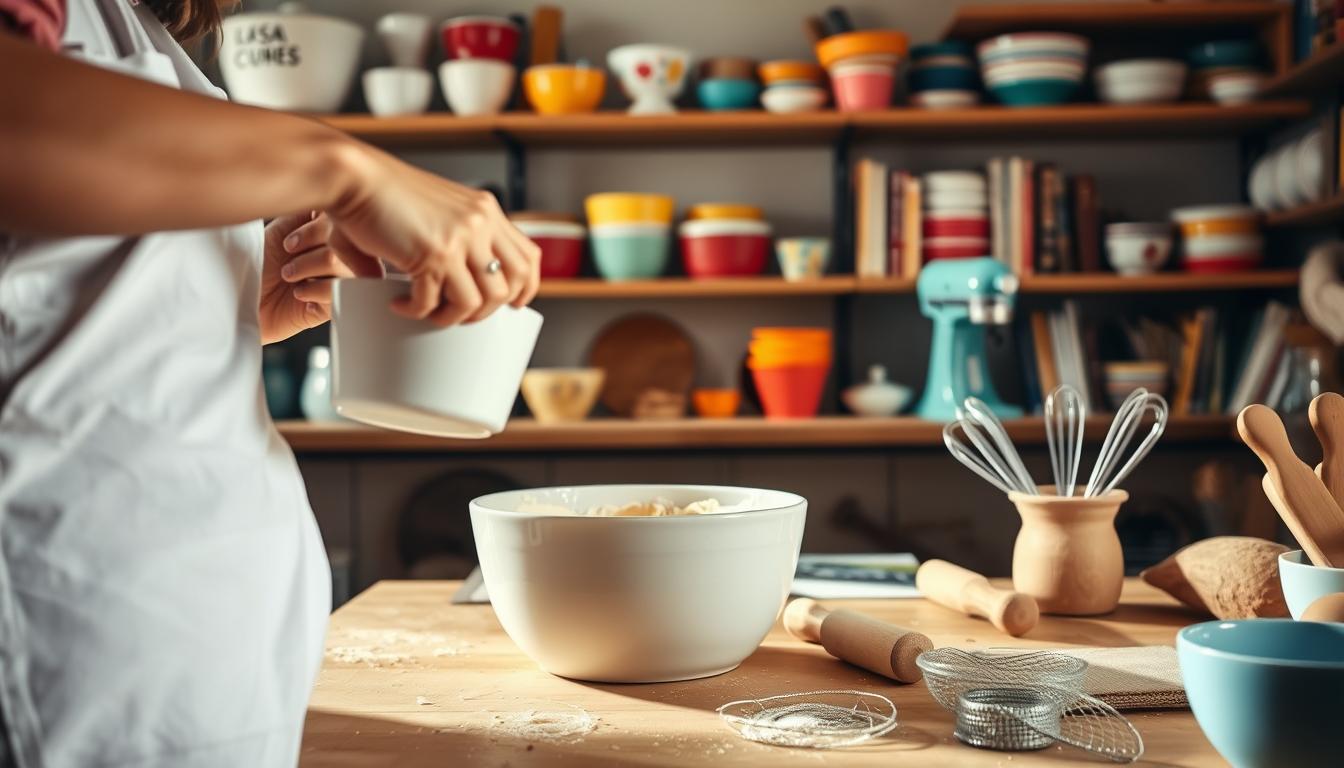The smell of a freshly baked cake can turn any kitchen into a cozy haven. I remember watching my grandmother measure ingredients with such care. Her hands moved with a magic that seemed almost real. Cake making is more than just following a recipe; it’s about making memories that last forever.
Baking homemade cakes might seem scary, but it’s easy with the right techniques. This guide will show you how to make delicious cakes in seven simple steps. Whether you’re new to baking or want to get better, you’ll impress everyone with your creations.
Cake making is a way to show love. It’s about choosing the best ingredients and mixing them just right. Our guide will make complex techniques simple, so you can create amazing cakes.
Get ready to turn your kitchen into a bakery. Learn to make delicious cakes from scratch. With a little patience and practice, you’ll make desserts that everyone will love.
Essential Tools and Equipment for Baking Success
Starting your cake-making journey needs the right tools and appliances. Professional bakers say quality equipment makes a big difference. Choosing the right measuring tools and mixing gear is key to success.
It’s not just about fancy appliances. It’s about picking tools that help you make delicious cakes every time.
Measuring Tools and Their Importance
Precision is crucial in baking. Digital scales have changed home baking by giving accurate measurements. They’re better than traditional cups because they remove guesswork.
- Digital kitchen scale (most accurate for dry ingredients)
- Liquid measuring cups with clear markings
- Dry measuring cups with level edges
- Measuring spoons in various sizes
Mixing Equipment Guide
| Mixing Tool | Best For | Pros |
|---|---|---|
| Hand Mixer | Small batches | Affordable, portable |
| Stand Mixer | Large recipes | Hands-free, powerful |
| Whisk | Manual mixing | Great for small tasks |
Baking Pans and Surfaces
Your baking pans affect cake texture and look. Invest in quality non-stick pans and try different shapes for variety. Silicone mats help with even heat and easy cleaning.
- Round cake pans
- Square baking dishes
- Bundt pans
- Silicone baking mats
With the right tools, you can make amazing cakes at home.
Understanding Cake Ingredients and Their Roles
Learning about cake ingredients is key to improving your cooking skills. Each part is important for making tasty, well-textured treats. Knowing how these ingredients work together can make your baking look like a pro’s.
Flour is the base of your cake. Different flours change the texture and how dense it is:
- All-purpose flour: Great for most cakes
- Cake flour: Makes the cake lighter and fluffier
- Whole wheat flour: Adds a nutty taste and more nutrients
Sugar does more than just sweeten your cake. It adds moisture, makes the batter tender, and helps with browning. Professional bakers see sugar as a complex ingredient with many roles.
“Baking is a science, and ingredients are your laboratory tools.” – Unknown Pastry Chef
Eggs are essential for holding your cake together. They add structure, help mix ingredients well, and give flavor. Using room temperature eggs makes the batter mix better and more evenly.
Choosing the right ingredients is important. Fresh, top-quality ingredients lead to better results in your baking.
Proper Ingredient Temperature and Preparation
Understanding how ingredient temperature affects baking is key. Professional bakers know that preparing ingredients well can make a big difference. It can turn an ordinary cake into a truly special dessert.
Temperature is very important for the perfect cake texture. Ingredients at room temperature mix better. This makes the batter more consistent, which improves the cake’s quality.
Room Temperature Guidelines
To get the best baking results, follow these guidelines:
- Take butter and eggs out of the fridge 30-60 minutes before baking
- The ideal room temperature is between 68-72°F (20-22°C)
- Use a quick water bath to warm eggs fast
Butter Softening Techniques
Softening butter right is key for smooth cake batters. Here are some good ways to do it:
- Cut butter into small cubes to warm it evenly
- Put butter near a warm surface for 10-15 minutes
- Avoid microwaving, as it can melt butter unevenly
Egg Handling Tips
Eggs are very important in cake making. Proper egg handling ensures food safety and optimal baking results. To warm eggs quickly, place them in warm water for 5-10 minutes before using.
Pro tip: Never use eggs straight from the fridge. Cold eggs can make batters lumpy and cakes uneven.
Mastering the Art of Cake Making
To get better at making cakes, you need to learn the fine details. These details turn simple ingredients into tasty desserts. It takes practice, patience, and a love for baking to make magic happen in your kitchen.
Starting with the basics is key. You must pick the right ingredients and know how they work together. Every step you take is important for the cake’s texture and taste.
- Learn ingredient compatibility
- Practice consistent mixing methods
- Understand temperature requirements
- Develop keen observation skills
When you cream butter and sugar, you create air bubbles. These bubbles make your cake light and fluffy. Gentle folding is important to keep these bubbles from disappearing.
Baking is both a science and an art – precision meets creativity in every recipe.
Professional bakers don’t just follow recipes. They understand how ingredients work together. They also use their intuition and keep improving their skills.
With each cake you make, your skills will grow. Don’t be afraid to make mistakes. Every great baker started where you are now, eager to learn and make delicious treats.
Mixing Techniques for Perfect Cake Batter
Mastering baking techniques is key to making delicious homemade cakes. The way you mix your batter greatly affects the cake’s texture and taste. Knowing the right mixing methods can take your cake making to the next level.

Cake making needs precision and care, especially when mixing ingredients. Your mixing method can turn a light, fluffy cake into a dense, tough dessert.
Creaming Method Demystified
The creaming method is a basic technique in cake making. Here’s how to do it correctly:
- Start with room temperature butter
- Beat butter and sugar until light and fluffy
- Add eggs one at a time, mixing thoroughly
- Scrape down the sides of the bowl frequently
Incorporating Dry Ingredients
When adding dry ingredients to your batter, follow these tips:
- Sift flour and dry ingredients together
- Add dry ingredients in small batches
- Mix on low speed
- Stop mixing as soon as ingredients are combined
Preventing Overmixing
Overmixing is the enemy of tender cakes. Too much mixing can make the cake tough and chewy. Watch for these signs to avoid overmixing:
- Stop mixing when no flour streaks remain
- Batter should look just combined
- Use a spatula for final gentle mixing
- Avoid aggressive or prolonged mixing
Pro tip: Gentle mixing is key to achieving a soft, delicate cake crumb.
Oven Temperature and Baking Times
Mastering oven temperatures is key in cake making. Your baking techniques can make or break the perfect cake. Understanding how to control your oven is crucial for delicious results.
Preheating your oven is the first step in successful cake baking. Experts say to preheat for at least 10-15 minutes. An oven thermometer is your best friend for accurate temperature settings.
- Standard cake baking temperatures range between 325°F and 350°F
- Lighter cakes often require lower temperatures
- Denser cakes might need slightly higher heat
Different cake types and pan materials affect baking times. Ceramic and glass pans typically require lower temperatures compared to metal pans. Always adjust your baking techniques based on your specific recipe and baking equipment.
“Temperature precision separates good bakers from great ones.” – Professional Pastry Chef
Oven hot spots can cause uneven baking. Rotate your cake pan halfway through baking for even heat. This simple technique can dramatically improve your cake’s texture and appearance.
| Cake Type | Recommended Temperature | Typical Baking Time |
|---|---|---|
| Vanilla Sponge | 325°F | 25-30 minutes |
| Chocolate Layer Cake | 350°F | 30-35 minutes |
| Cheesecake | 325°F | 45-55 minutes |
Remember, every oven is unique. Invest time in understanding your specific appliance to perfect your cake making skills.
Testing Cake Doneness and Cooling Methods
Getting your cake just right is key to mastering baking. Knowing when it’s done and how to cool it is crucial. These steps can turn a good cake into a great one.
Toothpick Test Guidelines
The toothpick test is a simple yet crucial technique in cake making. Here’s how to perform it effectively:
- Insert a clean toothpick into the cake’s center
- Push the toothpick about 2 inches deep
- Remove the toothpick and check for batter residue
A perfectly baked cake will show one of these results:
| Toothpick Result | Cake Status | Action |
|---|---|---|
| Clean toothpick | Fully baked | Remove from oven |
| A few moist crumbs | Almost done | Let bake 2-3 more minutes |
| Wet batter | Needs more baking | Continue baking |
Proper Cooling Techniques
Cooling is a critical step in your baking techniques that impacts the cake’s final texture. Follow these professional culinary skills for optimal results:
- Let cake rest in pan for 10-15 minutes
- Use a wire rack for complete cooling
- Avoid cutting or frosting until fully cooled
Pro tip: Cooling allows the cake’s structure to set, preventing crumbling and ensuring a smooth frosting surface.
Basic Cake Decorating Techniques

Cake decorating turns a simple treat into a stunning masterpiece. It’s perfect for beginners or those wanting to improve their frosting skills. Learning basic techniques can take your baking to new levels.
First, prepare your cake for decorating. Make sure the layers are level for a stable base. A thin layer of frosting, called a crumb coat, seals in crumbs and smooths the surface for decoration.
- Essential cake decorating tools:
- Offset spatula
- Piping bags
- Decorating tips
- Turntable
Applying frosting smoothly takes practice and the right method. Use your spatula at a 45-degree angle and turn the cake on a turntable for even coverage. For beginners, patience is key to get that professional finish.
Simple techniques can make your cake pop:
- Create texture with a fork or comb
- Pipe simple borders using star tips
- Add fresh fruit or edible flowers
- Sprinkle decorative elements like chocolate shavings
Cake decorating is an art that gets better with practice. Don’t be afraid to try new things and find your own style in frosting and design.
Frosting Types and Application Methods
Learning frosting recipes is key in cake decorating. It turns a simple cake into a beautiful work of art. Knowing how to make and use different frostings will make your baking stand out and wow your guests.
Frosting does more than just taste good. It also makes your cake look smooth and inviting. This makes your cake both tasty and beautiful to look at.
Buttercream Foundations
Buttercream is the go-to frosting for any baker. It’s creamy and can be changed to fit any flavor you want.
- Classic vanilla buttercream
- Chocolate buttercream variation
- Cream cheese buttercream
Creating the Perfect Crumb Coat
A crumb coat is a thin layer of frosting that keeps cake crumbs in. It’s the first step to a cake that looks like it was made by a pro.
- Apply a thin, even layer of buttercream
- Chill the cake for 15-20 minutes
- Add the final decorative frosting layer
Pro tip: Keep your frosting at room temperature for the best consistency and spreadability.
Storage Tips and Shelf Life
Keeping your homemade cakes fresh is key. The way you bake affects how long they stay delicious. Learning how to store cakes right is crucial for keeping them fresh and preventing spoilage.
Different cakes need different storage methods. Frosted cakes and unfrosted ones have different needs. Knowing the best way to store your cake can make it last longer.
- Room temperature storage works best for most cakes
- Refrigeration can help preserve certain cake varieties
- Freezing offers long-term preservation options
When storing cakes, consider these key factors:
| Cake Type | Room Temperature | Refrigerator | Freezer |
|---|---|---|---|
| Frosted Cake | 3-4 days | Up to 1 week | 2-3 months |
| Unfrosted Layers | 2-3 days | Up to 5 days | Up to 3 months |
To keep your cake fresh, wrap it in plastic wrap or use an airtight container. Avoid exposing cakes to strong odors that might ruin their taste. Let refrigerated cakes come to room temperature before serving to restore their original texture and taste.
Freezing is best when you double-wrap cake layers in plastic wrap and aluminum foil. This prevents freezer burn and keeps the cake moist and flavorful. Thaw frozen cakes slowly in the refrigerator to preserve their quality.
Common Cake Making Mistakes to Avoid
Mastering cake making takes practice and knowing common pitfalls. Even skilled bakers face challenges that affect their skills. Recognizing and avoiding these mistakes will help you make tasty homemade treats with confidence.
Professional baking needs precision and detail. Common errors can turn a great cake into a letdown.
Measurement Mishaps
Getting measurements right is key in cake making. Baking is a science that needs exact amounts. Here are mistakes to avoid:
- Using volume measurements instead of weight measurements
- Incorrectly scooping flour, which can lead to dense cakes
- Eyeballing ingredients instead of using proper measuring tools
Temperature Troubles
Temperature is crucial in cake making. It affects both ingredients and the oven:
- Using cold eggs or butter can prevent proper ingredient integration
- Preheating the oven incorrectly leads to uneven baking
- Opening the oven door frequently disrupts baking temperature
Mixing Missteps
The mixing process is delicate in cake making. Too much or too little mixing can change the cake’s texture:
- Overmixing develops excess gluten, creating tough cakes
- Undermixing leaves ingredient pockets in the batter
- Mixing at incorrect speeds can trap too much or too little air
Understanding these mistakes will improve your baking. You’ll make cakes that impress everyone.
Conclusion
Cake making is an art that combines precision, creativity, and passion. By mastering the baking techniques in this guide, you’ll become a confident home pastry chef. Each step you learn brings you closer to making delicious homemade cakes that will wow family and friends.
Your success in cake making comes from practice and patience. Start with simple recipes and then try more complex ones. Remember, every professional baker started where you are now – learning and experimenting.
The joy of baking is more than just the final product. It’s about measuring ingredients, mixing batters, and watching your creation rise. Your homemade cakes are more than dessert; they’re expressions of love and celebration. Keep exploring and enjoy your baking journey.
As you get better, don’t be afraid to try new things. Your kitchen is your canvas, and each cake is a story waiting to be shared. Experiment with unique flavors, decorating techniques, and personal touches.

